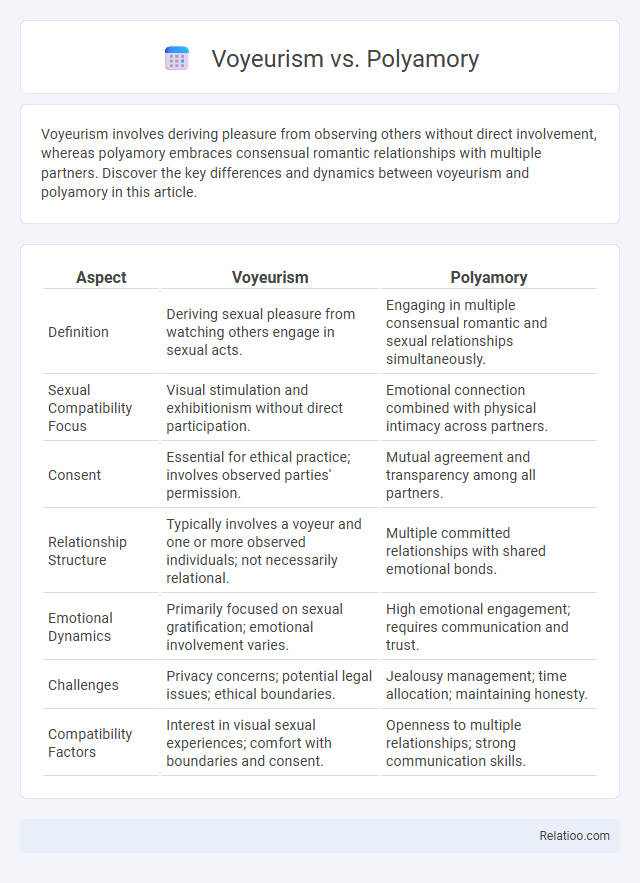Voyeurism involves deriving pleasure from observing others without direct involvement, whereas polyamory embraces consensual romantic relationships with multiple partners. Discover the key differences and dynamics between voyeurism and polyamory in this article.
Table of Comparison
| Aspect | Voyeurism | Polyamory |
|---|---|---|
| Definition | Deriving sexual pleasure from watching others engage in sexual acts. | Engaging in multiple consensual romantic and sexual relationships simultaneously. |
| Sexual Compatibility Focus | Visual stimulation and exhibitionism without direct participation. | Emotional connection combined with physical intimacy across partners. |
| Consent | Essential for ethical practice; involves observed parties' permission. | Mutual agreement and transparency among all partners. |
| Relationship Structure | Typically involves a voyeur and one or more observed individuals; not necessarily relational. | Multiple committed relationships with shared emotional bonds. |
| Emotional Dynamics | Primarily focused on sexual gratification; emotional involvement varies. | High emotional engagement; requires communication and trust. |
| Challenges | Privacy concerns; potential legal issues; ethical boundaries. | Jealousy management; time allocation; maintaining honesty. |
| Compatibility Factors | Interest in visual sexual experiences; comfort with boundaries and consent. | Openness to multiple relationships; strong communication skills. |
Understanding Voyeurism: Definition and Characteristics
Voyeurism involves gaining sexual pleasure from watching others who are unaware or non-consenting, distinguishing it as a paraphilic behavior often linked to privacy violations and potential legal consequences. Polyamory, in contrast, emphasizes consensual, ethical non-monogamous relationships based on open communication and mutual agreement among all involved parties. Understanding voyeurism requires recognizing its characteristic features, including secretive observation, lack of consent, and the psychological focus on control and arousal through forbidden acts.
What is Polyamory? Fundamental Principles Explained
Polyamory is the practice of engaging in multiple consensual romantic relationships simultaneously, emphasizing transparency, honesty, and mutual consent among all parties involved. Unlike voyeurism, which involves deriving pleasure from observing others without participation, polyamory centers on open communication and ethical non-monogamy to foster emotional intimacy and trust. Key principles include respect for boundaries, ongoing consent, and prioritizing emotional well-being across diverse relational dynamics.
Key Differences Between Voyeurism and Polyamory
Voyeurism involves deriving pleasure from observing others without their knowledge or consent, often related to private or sexual situations, whereas polyamory is a consensual, ethical practice of engaging in multiple romantic or intimate relationships simultaneously. The key difference lies in consent and openness--voyeurism lacks mutual agreement and invades privacy, while polyamory emphasizes honesty, communication, and mutual consent among all parties involved. Understanding these distinctions is crucial for recognizing boundaries, respecting autonomy, and fostering healthy interpersonal dynamics.
Psychological Motivations: Voyeurism vs. Polyamory
Psychological motivations for voyeurism often center on the thrill of observing others without their knowledge, driven by curiosity, power dynamics, or sexual gratification from secrecy. In contrast, polyamory is motivated by the desire for multiple intimate relationships based on consent, communication, and emotional connection, emphasizing openness and mutual respect. Understanding these differing motivations highlights voyeurism's association with secrecy and control, while polyamory reflects a commitment to honesty and relational transparency.
Social Perceptions and Stigma: A Comparative View
Social perceptions of voyeurism are predominantly negative, often associated with privacy invasion and legal consequences, leading to significant stigma. Polyamory is increasingly recognized as a valid consensual relationship style, though it still faces misunderstanding and moral judgment in many cultures. Voyeurism, as a non-consensual practice, carries a heavier social stigma compared to polyamory, which emphasizes ethical openness and mutual consent.
Ethical Considerations in Voyeurism and Polyamory
Ethical considerations in voyeurism center on consent, privacy, and respect for individuals' autonomy, as non-consensual observation violates personal boundaries and legal standards. Polyamory emphasizes transparency, mutual consent, and honest communication among all partners to maintain emotional well-being and trust. Your understanding of these distinctions promotes respecting personal rights and navigating relationships with integrity and empathy.
Consent and Boundaries in Both Practices
Consent and boundaries are fundamental in both voyeurism and polyamory, but they manifest differently according to the dynamics of each practice. In voyeurism, explicit consent from all parties involved is essential to ensure ethical engagement, respecting personal privacy and autonomy. Your understanding and communication of clear boundaries in polyamory allow for transparent, respectful relationships where all partners agree on the extent of emotional and physical connections.
Impact on Relationships and Intimacy
Voyeurism, polyamory, and exhibitionism each uniquely impact relationships and intimacy by shaping trust, communication, and emotional connection. Voyeurism often introduces secrecy and boundaries centered around observation without direct involvement, potentially causing discomfort or mistrust if unshared. Polyamory fosters open communication and consensual emotional bonds with multiple partners, enhancing intimacy through transparency, while exhibitionism emphasizes external expression of sexuality, which may either strengthen or challenge intimacy depending on mutual acceptance.
Navigating Legal Issues: Voyeurism vs. Polyamory
Navigating legal issues surrounding voyeurism versus polyamory requires understanding that voyeurism involves non-consensual observation, which is illegal in many jurisdictions, whereas polyamory centers on consensual, ethical non-monogamous relationships. Your rights and responsibilities differ significantly, with voyeurism often leading to criminal charges and polyamory falling under personal relationship choices protected by privacy laws. Clear communication, consent, and awareness of local statutes are essential to avoid legal complications in either context.
Embracing Diversity: Healthy Exploration and Communication
Embracing diversity in relationships involves understanding the distinctions between voyeurism, polyamory, and consensual non-monogamy, emphasizing healthy exploration and communication. Voyeurism, often focused on non-consensual observation, contrasts with polyamory, which centers on consensual, ethical multiple relationships built on trust and open dialogue. Prioritizing transparent communication and respecting boundaries fosters an environment where diverse relationship styles can thrive healthily and ethically.

Infographic: Voyeurism vs Polyamory
 relatioo.com
relatioo.com